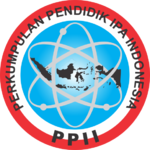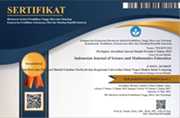Mathematical framework for accurate prayer times: Insights from the bencet tradition
Abstract
Keywords
Full Text:
PDFReferences
S. Resvito, Mathematics in Society and History. London: Kluwer Academic Publishers, 1992.
U. D’Ambrosio, An Overview of the History of Ethnomathematics. Hamburg : Springer Open, 2016.
R. L. Wilder, Mathematics as a Cultural System. New York: Pegamon Press, 2014.
U. D’Ambrosio, Ethnomathematics: Link between traditions and modernity. The Netherlands: Sense Publishers, 2006.
M. Rosa and M. E. Gavarrete, An Ethnomathematics Overview: An Introduction. Hamburg : Springer, 2017.
U. D. Ambrosio, “Ethnomathematics and Its Place in the History and Pedagogy of Mathematics,” Learning, vol. V, no. 1, pp. 44–48, 2012.
A. Hendriyanto, N. Priatna, D. Juandi, J. A. Dahlan, L. H. Muhaimin, and S. Sahara, “Learning Mathematics Using an Ethnomathematics Approach : A Systematic Literature Review,” vol. XXIII, no. 7, pp. 59–74, 2023.
M. Rosa and D. C. Orey, “Symmetrical Freedom Quilts: The Ethnomathematics of Ways of Communication, Liberation, and Art.,” RLE- Rev. Latinoam. Etnomatemática [electronic only], vol. II, no. 2, pp. 52–75, 2009.
B. Barton, “Ethnomathematics: Exploring Cultural Diversity in Mathematics,” Am. Ethnol., vol. XXI, no. 4, pp. 922–923, 1996.
J. P. Makonye, “Towards a culturally embedded Financial Mathematics PCK framework,” Res. Math. Educ., vol. XXII, no. 2, pp. 98–116, 2020.
O. A. Cimen, “Discussing Ethnomathematics: Is Mathematics Culturally Dependent?,” Procedia - Soc. Behav. Sci., vol. CLII, no. 1, pp. 523–528, 2014.
D. Muhtadi, Sukirwan, Warsito, and R. C. I. Prahmana, “Sundanese ethnomathematics: Mathematical activities in estimating, measuring, and making patterns,” J. Math. Educ., vol. VIII, no. 2, pp. 185–198, 2017.
R. C. I. Prahmana, “Ethno ‑ Realistic Mathematics Education : The promising learning approach in the city of culture,” SN Soc. Sci., vol. II, no. 12, pp. 1–19, 2022.
R. C. I. Prahmana and U. D’Ambrosio, “Learning geometry and values from patterns: Ethnomathematics on the batik patterns of yogyakarta, indonesia,” J. Math. Educ., vol. XI, no. 3, pp. 439–456, 2020.
I. N. F. Nisa’, “Penggunaan, Perhitungan, dan Akurasi Jam Bencet dalam Tinjauan Software Accurate Times dan Aplikasi Muslim Pro,” Al-Ahkam J. Ilmu Syari’ah dan Huk., vol. VI, no. 1, pp. 89–112, 2021.
M. Saihu, “Creating Community Based on Religion and Culture: Social Learning In Hindu and Muslim Relationships in Bali,” Edukasi Islam. J. Pendidik. Islam, vol. X, no. 1, pp. 219–246, 2021.
D. S. Padang and M. S. Lubis, “Ethnomathematical Exploration of Traditional Agricultural Tools in Hutamanik Village, Sumbul Regency,” Indones. J. Sci. Math. Educ., vol. VI, no. 2, pp. 137–151, 2023.
J. Munthahana, M. T. Budiarto, and A. Wintarti, “The Application of Ethnomathematics in Numeracy Literacy Perspective: A Literature Review,” Indones. J. Sci. Math. Educ., vol. VI, no. 2, pp. 177–191, 2023.
J. Soebagyo and F. I. Luthfiyyah, “Ethnomathematics Exploration of The Great Mosque of Al-Barkah, Bekasi City, Through The Learning of Geometry and Transformational Geometry,” Indones. J. Sci. Math. Educ., vol. VI, no. 2, pp. 152–164, 2023.
F. Saadah, A. Antariksa, and C. B. Amiuza, “Ethnomathematics: Mathematical Concepts in Sigale-Gale Statues,” Indones. J. Sci. Math. Educ., vol. VI, no. 2, pp. 1–8, 2016.
R. Rusli and T. N. Safaah, “Research Trend on Ethnomathematics from 2012 To 2022: A Bibliometric Analysis,” Indones. J. Sci. Math. Educ., vol. VI, no. 1, pp. 37–47, 2023.
Lexy J. Moloeng, Metodologi Penelitian Kualitatif. Bandung: PT Remaja Rosdakarya, 2019.
J. Creswell, Educational Research. California : SAGE, 2015.
S. Sutama, Metode Penelitian Pendidikan Kuantitatif, Kualitatif, PTK, Mix Method, R&D. sukoharjo: CV Jasmine, 2019.
M. B. Miles, A. M. Huberman, and J. Saldaña, Qualitative Data Analysis. London: SAGE Publication, 1994.
B. Jaworski, M. G. Bartolini Bussi, S. Prediger, and E. Nowinska, “Cultural contexts for European research and design practices in Mathematics Education,” Proc. Ninth Congr. Eur. Soc. Res. Math. Educ., vol. X, no. 1, pp. 7–33, 2015.
M. Jurdak, Learning and Teaching Real World Problem Solving in School Mathematics. New York: Springer, 2016.
R. Angraini and F. Rakhmawati, “Ethnomathematics Exploration of Fish Trader Activities in The Traditional Market of Punggulan Village, Asahan Regency,” Indones. J. Sci. Math. Educ., vol. VI, no. 2, pp. 213–226, 2023.
B. Atweh, H. Forgasz, and B. Nebres, Sociocultural research on mathematics education: An international perspective. New York: Psychology Press, 2001.
U. (1993). D’Ambrosio, “Etnomatemática: Um programa [Ethomathematics: A program]. A Educação Matemática em Revista,” vol. I, no. 1, pp. 5–11, 1993.
U. D’Ambrosio, “Literacy, Matheracy, and Technocracy: A Trivium for Today,” Math. Think. Learn., vol. I, no. 2, pp. 131–153, 1999.
M. Rosa and D. C. Orey, “A trivium curriculum for mathematics based on literacy, matheracy, and technoracy: an ethnomathematics perspective,” ZDM - Int. J. Math. Educ., vol. XLVII, no. 4, pp. 587–598, 2015.
P. Gerdes, “Reflections on Ethnomathematics,” Learn. Math., vol. XIV, no. 2, pp. 19–22, 1994.
DOI: http://dx.doi.org/10.24042/ijsme.v6i3.19790
Refbacks
- There are currently no refbacks.
Copyright (c) 2023 Unit Riset dan Publikasi Ilmiah FTK UIN Raden Intan Lampung

This work is licensed under a Creative Commons Attribution-ShareAlike 4.0 International License.

Indonesian Journal of Science and Mathematics Education is licensed under a Creative Commons Attribution-ShareAlike 4.0 International License.





